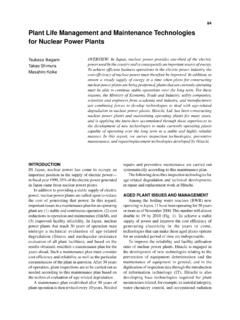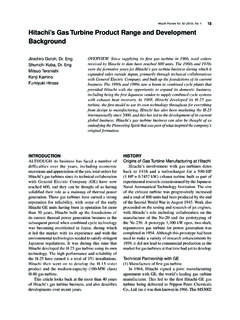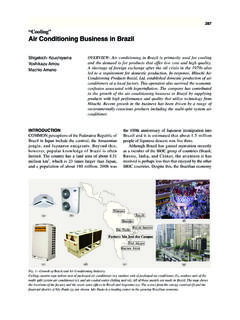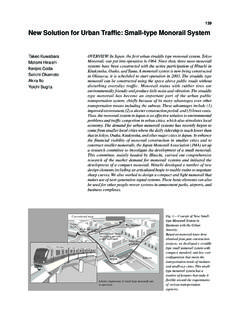Transcription of Next-generation SCADA and Control Technologies …
1 Hitachi Review Vol. 60 (2011), No. 3 143. Next-generation SCADA and Control Technologies for Large-scale Use of photovoltaic generation on electric power Grid Masahiro Watanabe OVERVIEW: How to maintain the quality of electric power on the grid in Tsukasa Onishi terms of voltage and other parameters and ensure that equipment operates Takahiro Omori efficiently will be important considerations if large quantities of solar power generation are to be connected. In response, Hitachi is working on Hirofumi Terada technology development with the aims of introducing equipment such as Masahiro Adachi section switches with built-in sensors and advanced metering infrastructure, Katsutoshi Inagaki developing Control equipment, and enhancing monitoring and Control . In particular, research and development of SCADA system Technologies and voltage Control equipment that help maintain power quality on the grid are helping to speed up preliminary investigations into how to maintain power quality and minimize the cost of adapting the grid to cope when large amounts of photovoltaic and other distributed power resources are introduced, thereby helping achieve reductions in CO2 emissions.
2 INTRODUCTION (2) Grid operation: The difficulty of estimating PV. THE installed capacity of PV ( photovoltaic ) power generation makes management of power flows more generation is increasing year by year and the complex and makes it more difficult to determine the government of Japan has set capacity targets equivalent actual load at consumer premises. to 28 GW in 2020 and 53 GW in 2030. Of the 2020 (3) Protection and maintenance: Preventing target, it is anticipated that 70% will be installed on misoperation of protection relays, preventing domestic dwellings and the majority of this connected individual running (generator continuing to run after to the distribution grid. Connecting large amounts of disconnection from grid). PV capacity to the grid raises the following issues This article describes SCADA (supervisory that need to be considered and progress made on Control and data acquisition) system Technologies developing technical solutions.
3 That help maintain power quality on the grid with a (1) power quality: Voltage rises caused by variation in focus on voltage Control techniques for managing grid PV output, measures for controlling variation voltage, something that will become an important issue in the future. CONCEPTS BEHIND NEXT generation . 6,600 V. Substation Current (2) Change tap (3) Q output OF SCADA AND Control . I (P+jQ) SVR. High-voltage line Feeder r+jx r+jx Overview of Grid Voltage Control (1) Change tap 6,750/ Q Q The electric power grid in Japan supplies power Pole-mounted 105V SVC. transformer Low-voltage line PCS PCS to homes through high-voltage distribution lines that Feeder line originate at substations and then via pole-mounted PV. (1). Upper limit (2) (3). transformers to low-voltage distribution lines and Voltage 6,600 V feeder lines (see Fig. 1). On a grid with no distributed Lower limit power sources, the voltage drops the closer one gets to SVR: step voltage regulator SVC: static var compensator the edge of the grid.
4 Voltage regulation is performed PCS: power conditioning system PV: photovoltaic by switching of LRTs (load ratio transformers). Fig. 1 Overview of Grid Voltage Control . located at substations and tapped Control at SVRs The voltage is adjusted using the substation transformers, (step voltage regulators) located on the power lines. changing SVR taps, and by Control of SVC reactive power (Q). Because fluctuations in voltage are likely to occur Next-generation SCADA and Control Technologies for Large-scale Use of photovoltaic generation on electric power Grid 144. due to variations in output if a significant amount new Technologies will also become important factors of PV generation is introduced, it is anticipated that, in improving the accuracy of grid status monitoring. in addition to making good use of the LRTs, SVRs, (2) More sophisticated voltage Control (improve and other existing equipment, systems such as SVCs controllability). (static var compensators) able to make rapid changes Another approach is to install additional voltage in voltage and PCSs ( power conditioning systems) that Control equipment to complement the existing LRTs are able to perform PV reactive power Control will also and SVRs and help maintain the voltage either through prove effective in suppressing voltage fluctuations on autonomous or coordinated operation.
5 Potential the high-voltage lines. Meanwhile, it is also anticipated voltage Control equipment includes distribution SVCs that low-voltage grids incorporating PV installed on and pole-mounted transformers with a voltage Control homes will experience similar voltage fluctuations capability as well as the use of the batteries in electric and that this voltage problem will become the greatest vehicles and PCSs for distributed power sources to challenge for distribution grids in the future. perform Control of reactive and active power . DSM. (demand-side management) to Control the operation of Future Directions for SCADA consumer equipment is also being considered. Two approaches can be taken to the monitoring and In this way, by improving observability and Control of grid voltage. controllability to allow detailed monitoring and (1) Determine situation on grid (improve observability) Control , it is possible to implement voltage management Whereas grids in the past have been limited to slow- measures that can cope efficiently with an increase in rate measurements of a subset of data from automatic load equipment of different types when PV generation switches on the high-voltage lines, utilities in recent is introduced.
6 What will be important to achieving this years have been working toward improvements such will be the development of various instrumentation, as collecting measurements from each phase using communications, grid status monitoring techniques, switches with built-in sensors and increasing the speed and Control equipment along with techniques for of grid telecommunications. The widespread adoption autonomous, coordinated, and centralized Control . of automatic metering and future monitoring of the Along with the above improvements in Control status of PV generation , electric vehicles, and other performance, it is anticipated that Control techniques SCADA system (front office) Grid business system (back office). Central office Grid equipment Distribution Database server Grid engineering Data management support of fault data (DWH) work planning system integration server Monitoring Voltage and Host system and Control management distribution server server server (including support for power calculation) Management system for automatic collection Intranet of remote meter data Console Metering network Substation PV.
7 Distributed power distribution grid integration Pole-mounted inspection Equipment design terminal transformer with terminal Grid analysis terminal voltage regulation New telecontrol capability New Meter data IP network for grid automation system equipment collection SVC. High-speed repeater High-speed High-speed High-speed Conventional General office communications slave stations slave stations slave stations slave stations terminator Console High-speed communication line Equipment Distributed Conventional Conventional communication line design terminal integration terminator Grid analysis inspection terminal terminal PHEV. SCADA : supervisory Control and data acquisition DWH: data warehouse IP: internet protocol PHEV: plug-in hybrid electric vehicle Fig. 2 Example Configuration of SCADA System. Efficient management of voltage and equipment can be achieved by adopting a comprehensive system configuration and by interconnecting the front office and back office computer network systems from sensors, slave stations, and a communication network.
8 Hitachi Review Vol. 60 (2011), No. 3 145. will evolve as follows. SVC/SVR coordinated Control function (1) Local Control X Q (Reactive power ). V Q X Voltage (kV) Reference Control based on local information (existing voltage SVR techniques), dual heavy-load/light-load setting, etc. Wind power (2) More sophisticated equipment setting V connection New system (SVR + SVC). Transformer Optimize equipment Control parameters based on Previous system (SVR only). 0 1 2 3 4 5. measured data. Controller Inverter Time (min). Previous (3) Autonomous, coordinated, and centralized Control system SVR operation DC. Wide-area Control using data from other locations SVC Capacitor New SVC operation system SVR operation obtained via communication links, coordinated Control that takes account of operation of other equipment, DC: direct current Control for overall optimization based on data from Fig. 3 Self-commutated SVC for Use on Grid (300 kVA). wide area, etc.
9 The system can coordinate operation with an SVR using local data. Example SCADA System Configuration System configurations need to be designed so that measurement data can be collected and utilized for Fig. 3 shows an overview of a self-commutated Control . A comprehensive system with tight integration SVC for use on power grids. of measurement data can potentially be configured Through joint research with Tohoku electric power from grid sensors, slave stations, communication Co., Inc. and Tohoku electric Manufacturing Co., Ltd., networks, and front office (monitoring and Control Hitachi has already commercialized a 300 kVA grid systems) and back office (grid business systems) SVC capable of coordinated operation with SVRs computer network systems. using local data. The system works by using the SVC. Fig. 2 shows a block diagram of such a system. to handle short-duration voltage fluctuations (from The front office system consists of a high-speed several tens of milliseconds up to several tens of communication network in which various data for each seconds) and the SVR to handle the variation in load phase are collected from switches with built-in sensors through the day and other long-period fluctuations.
10 By a monitoring and Control server at high speed and Although the main focus during the initial development utilized to determine the status of the grid. Meanwhile, was dealing with transient voltages caused by the in- meter data from consumer premises are collected by rush current that occurs when induction-motor-type an automatic remote meter reading system via the wind power generators are linked to the grid, the metering network. The grid equipment management system can also be effective for dealing with voltage support server that acts as an intermediary between fluctuations caused by the rapid changes in output the front and back office systems collects this data that occur with PV generation . Work is continuing on along with various equipment data for each pole- utilizing the latest power electronics to reduce the size mounted transformer and grid section. By allowing and cost of the systems. load estimation to be performed for each grid section, for example, and when used in conjunction with Transformers with Voltage Regulation Capability other systems including commercial design systems One way of performing voltage regulation on low- and grid analysis techniques for automating power voltage grids is to incorporate a voltage regulation distribution, this provides benefits which include more capability into the transformers used to convert from appropriate grid operation and distribution equipment the high-voltage grid voltage to 100 or 200 V.












